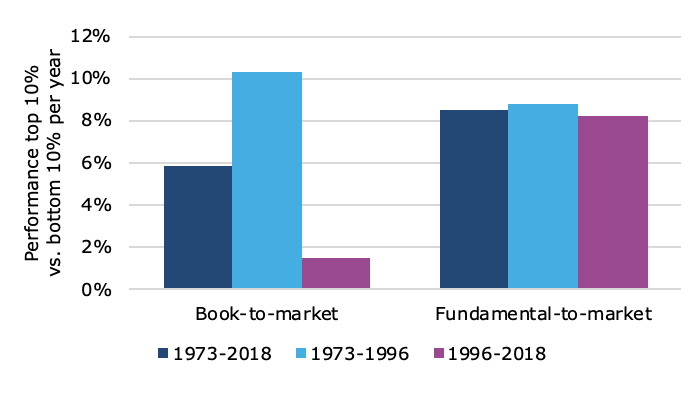It is well-known that value investors are going through a really hard time. Even Eugene Fama and Ken French admit that the size of the value factor has declined since the publication of their publication in 1991. I have written before about value and its dependence on the market environment, but a new study from the University of North Carolina presents another, more fundamental explanation.
They look at the OG of all value metrics the book-to-market ratio used by Fama and French (i.e. the inverse of the Price/Book-ratio commonly used by practitioners). They claim that since the 1970s accounting rules and corporate finance practices have changed significantly. Most notably, companies now have an increasing amount of capitalised goodwill and other intangibles on their books. These intangibles increase book value but are not a form of productive capital in the sense that they produce cash flows that are converted into dividends, share buybacks and other revenues for shareholders.
They then calculate a fundamental value that excludes such unproductive forms of capital. The resulting fundamental-to-market ratio is very similar to the book-to-market ratio in the 1970s but starts to diverge more and more in the 1980s and afterward. The correlation of changes in book-to-market ratio with changes in fundamental-to-market ratio was about 0.8 in the 1970s but has since declined to 0.19 in the most recent two-year period.
Correlation between book-to-market and fundamental-to-market ratio

Source: Goncalves and Leonard (2020).
When one then sorts stocks not on book-to-market ratio but instead on this fundamental-to-market ratio, the value premium does not disappear but remains constant over time. Ét voilà, value investing is alive and kicking again.
Outperformance of value vs. growth stocks

Source: Goncalves and Leonard (2020).




I re-read this today (3 Feb 2023) and have only one very obvious remark: if capitalised R&D and brand value appear on the balance sheet, they should not be subtracted from the company‘s book value, as both these line-items are likely to produce cash flows.